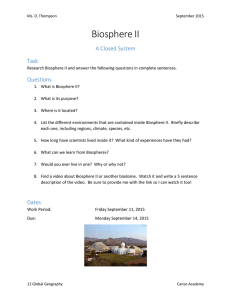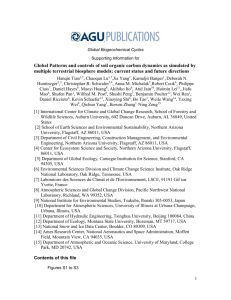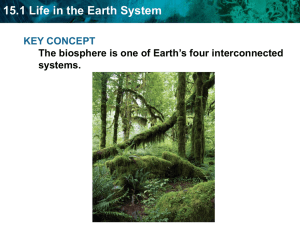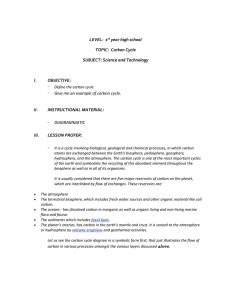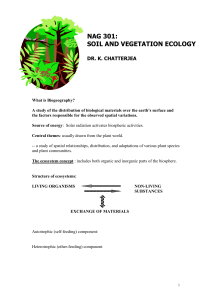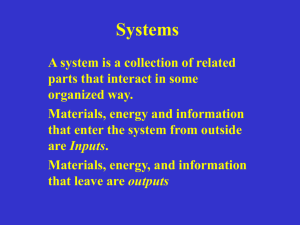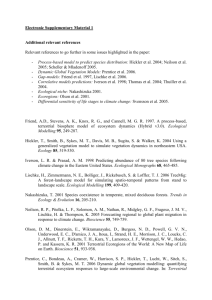Frontiers Ecology Environment in
advertisement
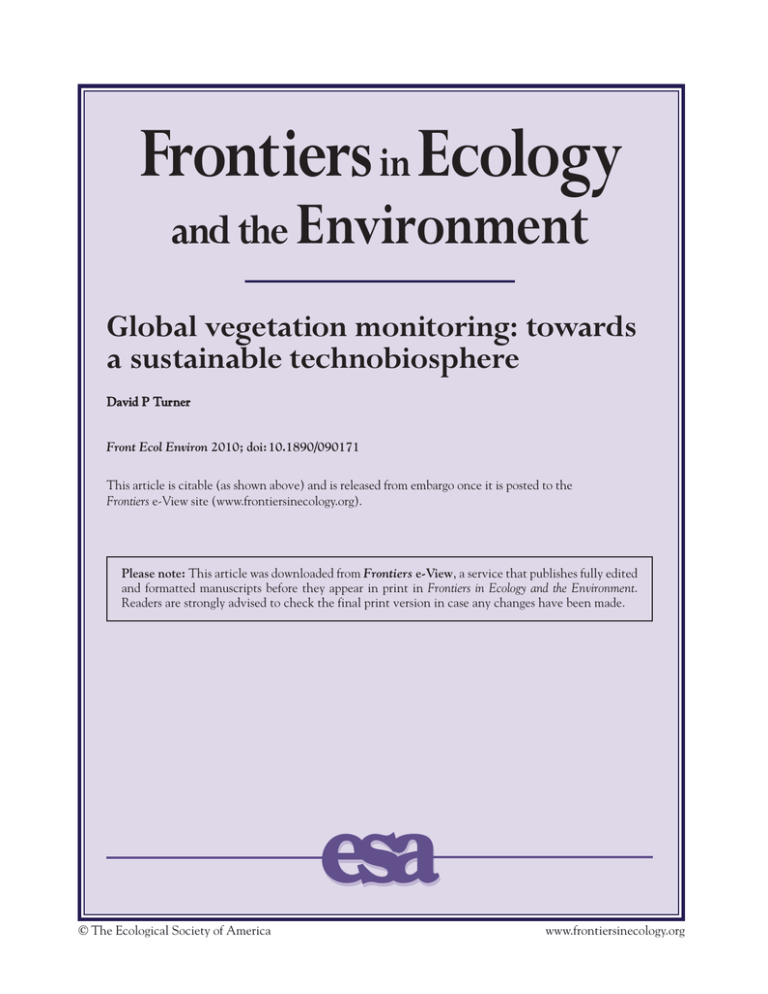
Frontiers in Ecology and the Environment Global vegetation monitoring: towards a sustainable technobiosphere David P Tur ner Front Ecol Environ 2010; doi:10.1890/090171 This article is citable (as shown above) and is released from embargo once it is posted to the Frontiers e-View site (www.frontiersinecology.org). Please note: This article was downloaded from Frontiers e-View, a service that publishes fully edited and formatted manuscripts before they appear in print in Frontiers in Ecology and the Environment. Readers are strongly advised to check the final print version in case any changes have been made. esa © The Ecological Society of America www.frontiersinecology.org REVIEWS REVIEWS REVIEWS Global vegetation monitoring: towards a sustainable technobiosphere David P Turner The concept of sustainable resource management can be applied at multiple scales. Monitoring is an essential component of sustainable natural resource management schemes, and as we begin to confront the need to manage natural resources at the global scale, the importance of monitoring at the global scale is also growing. The combination of satellite remote sensing, in situ measurements, and simulation modeling has the potential to deliver an annual assessment of status and trends for several measures of terrestrial biosphere structure and function relevant to sustainability. However, there is, as yet, no internationally coordinated effort in place to perform that analysis. Synthesis activity of that kind would support the development of global environmental governance institutions, including both non-governmental organizations and international bodies. Front Ecol Environ 2010; doi:10.1890/090171 T he scientific community has long recognized the nature of the global-scale, geophysical experiment that humanity is performing with greenhouse-gas emissions (Revelle and Suess 1957), and we are now beginning to see both geophysical and biophysical changes in the Earth systems (Clark et al. 2004). The terrestrial biosphere (here defined as all life on Earth’s land surface) is responding to anthropogenically driven changes in the atmosphere, and also to widespread land-cover and landuse change (Turner et al. 1990). The global scale of human impacts on the biosphere suggests the need for globally integrated monitoring of these impacts and, eventually, coordinated plans for mitigation and adaptation. Unfortunately, there is, at present, only a patchwork of mostly research-oriented efforts to monitor the terrestrial biosphere. A new level of coordination is required. Managing the Earth system Prior to the recent arrival of Homo sapiens, the biosphere was a complex adaptive system (Levin 1998), with a metabolism based on the capture of solar energy and the In a nutshell: • Satellite-borne sensors are capable of high spatial and temporal resolution monitoring of vegetation at the global scale • International coordination of terrestrial monitoring efforts has begun, but has not kept pace with the accelerating rate of human-driven changes • An annual “pulse of the planet” assessment of global vegetation – based on satellite remote sensing – would advance the development of global environmental governance institutions Division of Earth Systems Science, Department of Forest Ecosystems and Society, Oregon State University, Corvallis, OR (david.turner@ oregonstate.edu) © The Ecological Society of America cycling of nutrients (Kleidon 2004). Global ecologists continue to debate Gaia Theory: specifically, the role of the biosphere in maintaining the global climate in a range favorable to itself by way of its influence on the chemical composition of the atmosphere and on the surface energy balance (Schneider et al. 2004). This debate has at least made clear that the biosphere has a strong regulatory influence on global biogeochemical cycles and global climate (Pagani et al. 2009). The potential influence of humanity on the biosphere and on global biogeochemical cycles has been of scientific interest since at least the early 20th century, when Russian biogeochemist Vladimir Vernadsky likened technologically advanced humanity to a “geological force” (Vernadsky 1945). Indeed, the rapid development of technology through cultural evolution has led to the formation of a technosphere, ie a globe-girdling web of human artifacts, including buildings, machines, roads, and electronic devices (Figure 1). Like the biosphere, the technosphere follows a thermodynamic imperative to use energy in the service of maintaining and increasing order (Williams and Frausto da Silva 2006). The elaboration of the technosphere as a result of technological “advances” can be seen as a system composed of science, engineering, industry, and government. Science develops a mechanistic understanding of nature, engineering devises ways to use that knowledge, industry organizes the resources to manufacture and distribute the products of engineering, and government provides the infrastructure. The underlying foundation of this integration is the dynamic of capitalism, which is built on business interests and consumerism. To put it mildly: “under conditions of neo-liberal deregulation, heightened competition, and economic globalization, [that system] exhibits a strong tendency toward expansion” (Strydom 2002). The relationship between the technosphere and the biosphere has gained attention in recent years because of www.frontiersinecology.or g NASA/GSFC/Visualization Analysis Laboratory Global vegetation monitoring DP Turner pled system are a combination of solar energy and fossil fuels. A key mode of interaction between the biosphere and the technosphere is the global carbon (C) cycle. Anthropogenic transfers of C to the atmosphere by way of fossil fuel combustion and deforestation are nearly 10 PgC yr–1, a substantial flux relative to global terrestrial net primary production (NPP) of about 60 PgC yr–1 (Roy et al. 2001). Anthro-pogenic C emissions are essentially driving the Earth’s atmospheric composition and climate system toward conditions the biosphere has not experienced for at least 50 million years (Zachos et al. 2008). We can frame the question of technobiosphere management in terms of assessing the sustainability of the management scheme. Sustainability can have social and Figur e 1. The distribution and density of lights at night indicate the pervasive economic dimensions, but here we are conpresence of the technosphere. cerned with its ecological aspects, ie the ability to manage natural resources so that their growing interdependence. We increasingly think of all humans share at least a modest standard of living withhumanity and the technosphere as dependent on the out compromising the potential of those resources to probiosphere, in that ecosystem services, such as food pro- vide equal benefits to future generations (NRC 1999). duction and provision of clean water and clean air, are We have really just begun to understand what sustainabilcritical for human survival. Encouragingly, the recogni- ity means at the level of ecosystems, landscapes, bioretion and valuation of these ecosystem services (Con- gions, and the planet as a whole. Beyond the challenge of stanza et al. 1997) has provided an impetus towards achieving sustainability under a stable climate, lies the resource conservation. We are beginning to think of the problem of dealing with a rapidly changing climate. biosphere as threatened by the technosphere, and cerAt any geographical scale, a key issue in the sustainabiltainly the current wave of extinctions is testament to our ity of terrestrial ecosystems is maintaining vegetation destructive capacity. Technosphere disasters such as cover and productivity. Loss of vegetation cover often Chernobyl also come to mind. means the beginning of ecosystem degradation, including In the context of the Earth’s history over geological time, loss of soil and its associated capacity for storing nutrients there doesn’t seem to be an issue with actual survival of the and water. Loss of cover also means a net transfer of C biosphere in the face of the current anthropogenic pertur- from the land to the atmosphere, along with changes in bation. Much of its metabolism is microbial, and Earth his- the surface energy balance. If these changes are spatially tory suggests that the microbial world can withstand even a extensive, they can induce changes in regional climate 95% reduction in the number of higher order species. (Pielke et al. 2002). Reductions in net primary productivStressed ecosystems (eg a polluted lake) often degrade into ity mean a reduced flow of energy through ecosystems, a state of lower biodiversity and energy throughput and, from a thermodynamic perspective, less energy to (Rapport and Whitford 1999). Thus, a stressed biosphere maintain structure and function (ie order). would likely persist, but for human purposes it would be Natural resource management schemes typically less hospitable than the vibrant biosphere we inherited. include a monitoring component, and the Earth science Although the technosphere represents a threat to the community has recently gained the capacity to monitor current configuration of the biosphere, it could also be the terrestrial biosphere – a step toward its management argued that there is a growing dependence of the bios- at the global scale. The National Aeronautical and Space phere – and its associated ecosystem services – on a prop- Administration’s Earth Observing System (EOS) uses erly functioning technosphere. If all the sewage treat- multiple Earth-orbiting satellites and includes a free data ment plants around the world failed, for instance, there distribution system over the internet that provides realwould certainly be a rapid decrease in water quality and time imagery for many applications (eg Townsend and in the viability of aquatic habitats for many organisms. Justice 2002). EOS and other observation systems are Human management of the technosphere is therefore complementary to an emerging set of data assimilation closely related to its management of the biosphere. models that prepare satellite data to produce spatially and The technobiosphere is a contemporary fusion of the temporally continuous simulations of the Earth system’s biosphere and the technosphere. Energy inputs to the cou- physical, chemical, and biological processes (Figure 2). www.fr ontiersinecology.or g © The Ecological Society of America DP Turner Global vegetation monitoring 2005 Annual mean land flux (gC m–2 y–1) –120 –40 0 40 120 Figure 2. Annual mean land flux for 2005 from CarbonTracker (http://carbontracker.noaa.gov; Peters et al. 2007). Land flux includes net ecosystem exchange (NPP – heterotrophic respiration) and direct fire emissions. Negative values are C uptake by the biosphere and positive values are C release. Estimates are based on remote sensing, distributed climate data, observations of CO2 concentrations, mapping of fossil-fuel emissions, and modeling. The year 2005 was relatively dry over the Amazon Basin, leading to increased C release. The information collected from global monitoring and modeling therefore provides a means to evaluate the effects of the technosphere on the biosphere and is becoming part of a critical feedback loop between global society and the biosphere. However, there is not an operational terrestrial biosphere monitoring network in place. Monitoring the terrestrial biosphere component of the technobiosphere Key indices of the technobiosphere that inform monitoring for ecological sustainability include vegetation cover (%), biomass, vegetation land use, NPP, and net ecosystem production (NEP, the net effect on C storage of gains through photosynthesis and losses through ecosystem respiration). Changes in vegetation type and cover are important in terms of tracking rates of urbanization, deforestation, and desertification, as well as insect outbreaks and wildfires. Land-use change, such as converting primary (ie old-growth) forest to tree plantations, relates to sustainability in the context of issues including preservation of biodiversity and rates of C uptake. Changes in global terrestrial NPP are of interest as indicators of biospheric inputs to the technosphere and of biospheric sensitivity to climate variability or change. About 40% of global terrestrial NPP is diverted from local ecosystems to the technosphere (eg biofuels) or to human consumption as food or fiber (Imhoff et al. 2004), and much of global NPP is managed locally in one way or another. Global analysis with the satellite-borne Advanced Very High Resolution Radiometer (AVHRR) sensor has suggested that global NPP increased approximately 6% over © The Ecological Society of America the 1982–1999 period, primarily in response to climate variation (Nemani et al. 2003). Large, ongoing changes in NPP related to agriculture, notably conversions of forest to cropland and introduction of irrigated areas, are also likely. After multiple years of satellite-data observations, a yearly NPP anomaly (ie the sign and magnitude of the difference between the current year value and the multiple year average) can be calculated for each pixel. That mapped information is informative with respect to geographic patterns in biosphere metabolism (Figure 3). Changes in global NEP and C stocks (principally biomass and soil) are of interest because terrestrial biosphere C sequestration is currently offsetting ~30% of anthropogenic emissions associated with fossil-fuel burning, cement manufacture, and deforestation. Uncertainty about the magnitude of that terrestrial offset is low at the global scale because the other components of the nearterm atmospheric C budget – the increase in atmospheric CO2, the anthropogenic sources, and the ocean sink – are reasonably well known. However, we do not yet have a solid understanding of the geographic distribution or underlying mechanisms of the terrestrial C sink and, consequently, how long it will continue is unknown. If the terrestrial C sink begins to diminish, atmospheric CO2 concentrations will begin to rise faster, putting more pressure on global efforts to reduce fossil-fuel emissions. Remote sensing is the foundation of efforts to monitor vegetation-related indices of global sustainability (Running et al. 1999). Several satellite-borne sensors with moderate spatial resolution (ie pixels on the order of 250–2000 m across) are now producing daily and weekly coverage of the Earth’s land surface. In the case of the www.frontiersinecology.or g Global vegetation monitoring DP Turner 2002 NPP Anomaly (gC m–2 y–1) –90 –30 0 30 90 Figure 3. Net primary production anomaly for 2002 from MODIS data (Zhao and Running 2008). Reference period is 2000–2006. Estimates are based on remote sensing, distributed climate data, and modeling. The year 2002 was relatively dry in western North America and Australia. MODIS (Moderate Resolution Imaging Spectroradiometer) sensor, all imagery (ie reflection in specific wavelengths) is freely available in near real time on the internet (https://lpdaac.usgs.gov/). The MODIS data were available beginning in 2000 and are used to produce annual maps of land-cover type, vegetation cover (%), and NPP at a spatial resolution of 1 km (Townsend and Justice 2002). Global NEP is more difficult to estimate with remote sensing than NPP because the release of CO2 through heterotrophic respiration is not as closely linked to surface reflectance as is the case with NPP. Nevertheless, firstorder, continental-scale NEP maps are also beginning to be produced using MODIS data (Potter et al. 2008). Other moderate resolution sensors with global coverage include SeaWiFS, VEGETATION, and MERIS, all of which have associated products related to vegetation monitoring. There are ongoing, internationally coordinated efforts to compare products from these sensors and perform ground validation (eg Morisette et al. 2006), but considering the magnitude of the research issues associated with application of remote-sensing data, these efforts are quite limited. There is no dedicated institution that performs an annual synthesis of terrestrial biosphere monitoring products. Fine resolution satellite sensors (10–100 m) are an essential complement to the moderate resolution sensors for monitoring vegetation change. The scale of the spatial heterogeneity associated with forest disturbances – including conversion to cropland, harvesting, and wildfire – is often much less than 1 km (Goward et al. 2008). The Landsat series of sensors operate at a spatial resolution of about 30 m and have permitted the monitoring of land-cover and landuse change since the early 1970s (Wulder et al. 2008). Like MODIS data, Landsat data are now freely available over the www.fr ontiersinecology.or g internet (through the US Geological Survey). The Landsat sensors are augmented by higher spatial resolution (1–2 m) commercial sensors, such as IKONOS. This scale is at the level of an individual tree or house. One general scheme for global-scale monitoring of land-cover change is to use moderate-resolution imagery for complete coverage and fineresolution imagery in areas where extensive and rapid change is detected (Hansen et al. 2008) In addition to these passive optical sensors (ie measuring reflected solar radiation), there are active radar and lidar sensors that are used in mapping vegetation biomass, canopy height, and canopy structure. The Geoscience Laser Altimeter System (GLAS) sensor was designed to track changes in glacier height, but has been adapted for estimating global vegetation biomass (Lefsky et al. 2006). As with optical sensors, huge data flows of raw imagery and research oriented products are available, but relatively little synthesis capacity is currently in place. Development of remote sensing-based biosphere monitoring products, such as global NPP and NEP, requires much more than just satellite imagery (Running et al. 1999). In situ observations of C fluxes at eddy covariance flux towers, which continuously measure the exchange of carbon between the atmosphere and the land surface over an area of about 1 km2, provide a basis for calibration and validation of the C cycle process models that integrate information on surface greenness, climate, and soil properties. Obser-vations of atmospheric CO2 concentration, when integrated with observations of climate, estimates of surface fluxes, and atmospheric transport models, allow evaluation of the modeled surface C fluxes and permit inversions to infer fluxes directly (Peters et al. 2007; Figure 2). The development of high-level products, such as © The Ecological Society of America DP Turner Global vegetation monitoring mapped NPP and NEP, is being done at multiple laboratories around the world. Here, I am advocating that we should maintain support for those programs, intensify coordination among them, and regularly synthesize their multiple products so we can take an annual “pulse of the planet”. Satellite-borne sensor Records time series observations of Earth relectance Data center Assembles data into usable form, performs quality checks, manages data storage Terrestrial monitoring and global MODIS (500m) VGT (1000m) MERIS (300m) NASA LPDAAC1 ESA JRC2 ESA JRC2 environmental governance The current model for global environmental Product center MODIS GLC2000 GlobCover Creates digital vegetation governance is largely based on organizations characterization products Land product associated with the United Nations. This model eg university or national laboratory is increasingly complemented by the efforts of transnational, non-governmental organizations International (NGOs), for example, organizations that certify Periodically updated moderate synthesis center that tropical-forest wood is being harvested susAnalyzes uncertainties and prepares resolution land cover map annual reports on status and trends tainably. The process of building a scientific consensus and following up with international negotiations and development of policy decisions has Policy community UNEP, WWF, WB, ...3 been successful in some cases (eg stratospheric Evaluates implications For example, reports on global and regional for human welfare and legislates ozone depletion), and will be prominent in the patterns in area of cropland per capita appropriate responses ongoing efforts to address global climate-change US National Aeronautics and Space Administration, Land Processes Distributed Active Archive Center issues. This model relies heavily on a high level European Space Agency, Joint Research Institute of synthesis of scientific observations. United Nations Environmental Program, World Wildlife Fund, World Bank Climate change provides a particularly compelling case for international coordination, Figure 4. Case study of global land-cover monitoring. Arrows represent data specifically with respect to terrestrial monitor- flows. General case is to the left and the sequences for specific sensors (with ing (DeFries et al. 2006). The UN Framework spatial resolution) are to the right. The proposed international synthesis center Convention on Climate Change, signed in the is highlighted. early 1990s by 154 countries – including the US, China, and India – contains a provision that requires Systems (GEOSS) is currently formulating policies regardannual estimates of C emissions from both fossil-fuel com- ing data sharing and data interoperability that will facilibustion and land-cover/land-use change. This agreement is tate access to critical satellite data. Likewise, the very relevant to terrestrial biosphere monitoring, because Community on Earth Observation Satellites (CEOS) is the deforestation source constitutes about 20% of the total committed to coordinating among national space agencies anthropogenic C emissions, and remote sensing is needed to “insure availability of current and future data supply on a basis adequate for the implementation and operation of to track deforestation and to estimate associated C flux. The Kyoto Protocol, which was aimed at reducing global continuous [C flux monitoring] services”. However, there greenhouse-gas emissions, had very limited provisions for remains the need for a project or institution that would C offsets associated with forestry, and therefore did not advocate for a coherent monitoring system and assemble require much biosphere monitoring. At the follow-up 2009 the various products from different agencies to produce UN Climate Change Conference, in Copenhagen, annual synthesis reports (Figure 4). A recent international Denmark, the concept of C offsets for reducing deforesta- workshop (www.ntsg.umt.edu/VEGMTG/) focused on the tion and forest degradation (REDD) was supported in the need for ensuring continuity in the satellite observations final Copenhagen Accord. Regional cap-and-trade agree- (by no means a certainty, eg Wulder et al. 2008) and for the ments are also beginning to be implemented, with a variety synthesis of products across complementary sensors. The of vegetation-based C offsets. It is therefore becoming NASA Decadal Survey (NRC 2007) supported developincreasingly important that effective monitoring of C ment of new sensors, but also emphasized the importance stocks and fluxes – from the project level, to the national of measurement continuity, which is critical to implementation of an operational monitoring scheme. level, to the global level – is implemented. The United Nations has traditionally been a strong Various national-level centers, such as the National Aeronautics and Space Administration (NASA)-funded advocate for global monitoring and is a logical home for a Land Processes Data Archive and Distribution Center, synthesis effort. However, operational programs in the UN assemble and distribute global monitoring datasets, but are still quite limited. The Food and Agriculture these institutions generally do not have an analytical func- Organization (FAO) has generally monitored global crop, tion. The international Global Earth Observing System of forestry, and fishery production by assembling national1 2 3 © The Ecological Society of America www.frontiersinecology.or g Global vegetation monitoring level inventory data into global summaries. In moving toward developing more integrated global monitoring, FAO has supported the formation of the Integrated Global Observing System (IGOS), which aims at comprehensive monitoring of the climate, oceans, and land. IGOS is broken out into about 20 subsidiary organizations, the most relevant here being the Global Terrestrial Observing System (www.fao.org/gtos/index.html). GTOS is currently seeking funding to support the establishment of one or more international data centers, responsible for synthesis of global vegetation-monitoring products (GTOS 2008). Conclusions The technobiosphere is a complex adaptive system, and the human component has not yet achieved a sustainable relationship with its other living elements. Monitoring is usually a key component of effective environmental management schemes and the rising tide of global-change issues suggests the need for a global terrestrial monitoring institution. There are several measures of sustainability at the global scale that are potentially observable by satelliteborne sensors, notably the status and trends in land cover, land use, biomass, NPP, and NEP. The information derived from an effort to synthesize relevant data on these measures of sustainability would support development and implementation of environmental policy and goals by both NGOs and international bodies. Acknowledgements Thanks to D Bella (Oregon State University) and S Running (University of Montana) for discussions on this topic, and to the Cooperative Institute for Research in Environmental Sciences at the University of Colorado for fellowship support. References Clark WC, Crutzen PJ, and Schellnhuber HJ. 2004. Science for global sustainability. In: Schellnhuber HJ, Crutzen PJ, Clark WC, et al. (Eds). Earth system analysis for sustainability. Cambridge, MA: MIT Press. Costanza R, d’Arge R, de Groot R, et al. 1997. The value of the world’s ecosystem services and natural capital. Nature 387: 253–60. DeFries R, Achard F, Brown S, et al. 2006. Reducing greenhouse-gas emissions from deforestation in developing countries: considerations for monitoring and measuring. Global Terrestrial Observing System for the United Nations (GTOS) Report, vol 46. http://nofc.cfs.nrcan.gc.ca/gofc-gold/Report%20Series/ GOLD_26.pdf. Viewed 23 Feb 2010. Goward SN, Masek JG, Cohen WB, et al. 2008. Forest disturbance and North American carbon flux. Eos 89: 105–16. GTOS (Global Terrestrial Observing System). 2008. Terrestrial essential climate variables. Global Terrestrial Observing System Publication # 52. www.fao.org/gtos/doc/pub52.pdf. Viewed 23 Feb 2010. Hansen MC, Stehman SV, Potapov PV, et al. 2008. Humid tropical forest clearing from 2000 to 2005 quantified by using multitemporal and multiresolution remotely sensed data. P Natl Acad Sci USA 105: 9439–44. Imhoff ML, Bounoua L, Ricketts T, et al. 2004. Global patterns in www.fr ontiersinecology.or g DP Turner human consumption of net primary production. Nature 429: 870–73. Kleidon A. 2004. Beyond Gaia: thermodynamics of life and Earth system functioning. Clim Change 66: 271–319. Lefsky MA, Harding DJ, Keller M, et al. 2006. Estimates of forest canopy height and aboveground biomass using ICESat. Geophys Res Let 33: L05501. Levin SA. 1998. Ecosystems and the biosphere as complex adaptive systems. Ecosystems 1: 431–36. Morisette JT, Baret F, Privette JL, et al. 2006. Validation of global moderate-resolution LAI products: a framework proposed within the CEOS Land Product Validation subgroup. IEEE Trans Geosci Rem Sens 44: 1804–17. Nemani RR, Keeling CD, Hashimoto H, et al. 2003. Climate-driven increases in global terrestrial net primary production from 1982 to 1999. Science 300: 1560–63. NRC (National Research Council). 1999. Our common journey: a transition toward sustainability. Washington, DC: National Academies Press. NRC (National Research Council). 2007. Earth science and applications from space: national imperatives for the next decade and beyond. Washington, DC: National Academies Press. Pagani M, Caldeira K, Berner R, et al. 2009. The role of terrestrial plants in limiting atmospheric CO2 decline over the past 24 million years. Nature 460: 85–89. Peters W, Jacobson AR, Sweeney C, et al. 2007. An atmospheric perspective on North American carbon dioxide exchange: CarbonTracker. P Natl Acad Sci USA 104: 18925–30. Pielke RA, Marland G, Betts, RA, et al. 2002. The influence of landuse change and landscape dynamics on the climate system: relevance to climate-change policy beyond the radiative effect of greenhouse gases. Philos T R Soc Lond A 360: 1705–19. Potter C, Boriah S, Steinbach M, et al. 2008. Terrestrial vegetation dynamics and global climate controls in North America: 2001–05. Earth Interact 12: 1–12. Rapport DJ and Whitford WJ. 1999. How ecosystems respond to stress – common properties of arid and aquatic systems. BioScience 49: 193–203. Revelle R and Seuss HE. 1957. Carbon dioxide exchange between atmosphere and ocean and the question of an increase of atmospheric CO2 during the past decades. Tellus 9: 18–27. Roy J, Saugier B, and Mooney HA (Eds). 2001. Terrestrial global productivity. San Diego, CA: Academic Press. Running SW, Baldocchi DD, Turner DP, et al. 1999. A global terrestrial monitoring network integrating tower fluxes, flask sampling, ecosystem modeling and EOS satellite data. Rem Sens Environ 70: 108–28. Schneider SH, Miller JR, Crist E, et al. (Eds). 2004. Scientists debate Gaia. Cambridge, MA: MIT Press. Strydom P. 2002. Risk, environment and society. Philadelphia, PA: Open University Press. Townsend JRG and Justice CO. 2002. Towards operational monitoring of terrestrial systems by moderate-resolution remote sensing. Rem Sens Environ 83: 351–59. Turner II BL, Clark WC, Kates RW, et al. (Eds). 1990. The Earth as transformed by human action: global and regional changes in the biosphere over the past 300 years. Cambridge, UK: Cambridge University Press. Vernadsky VI. 1945. The biosphere and the noösphere. Am Sci 33: 1–12. Williams RPJ and Fra sto da Silva JJR. 2006. The chemistry of evolution. Amsterdam, The Netherlands: Elsevier. Wulder MA, White JC, Goward SN, et al. 2008. Landsat continuity: issues and opportunities for land cover monitoring. Rem Sens Environ 112: 955–69. Zachos JC, Dickens GR, and Zeebe RE. 2008. An early Cenozoic perspective on greenhouse warming and carbon-cycle dynamics. Nature 451: 279–83. Zhao M and Running SW. 2008. Remote sensing of terrestrial primary production and carbon cycle. In: Liang S (Ed). Advances in land remote sensing. New York, NY: Springer. © The Ecological Society of America
